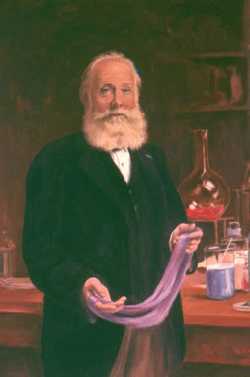 SKC Films Library |
| SKC Films Library >> Chemical Technology >> Biography |
| William Perkin inventor of synthetic mauve
William Henry Perkin was born in London's East End on March 12, 1838, the seventh child of George Fowler (a successful carpenter) and Sarah Perkin. He was attending the City of London School when, at the age of 14, schoolmaster Thomas Hall encouraged him to pursue chemistry. At the age of 15 he joined the Royal College of Chemistry in London, where he studied under August Wilhelm von Hofmann. Perkin spent his first couple of years at the College doing routine qualitative and quantitative chemistry, much of it involving coal tar and coal tar derivatives, under Hofmann's direction. A research problem involving anthracene proved unsolvable, but one involving napthylamine yielded the first of more than eighty papers to be written by Perkin. This work led Hofmann to name 17-year-old Perkin as his assistant. The job did not include independent research, however, so Perkin set up a laboratory in his Cable Street home so he could conduct experiments in the evenings and during vacation times, and it was there that he made the discovery which made him famous (and rich). During the Easter vacation of 1856 Perkin decided to tackle the synthesis of quinine (an anti-malarial drug) from coal tar, a project that Hofmann had been working on for several years without success. One attempt left Perkin with a dirty black sludge in the bottom of a flask, which he tried to clean out with alcohol. The cleaning process resulted in a purple substance that Perkin believed could be turned into a dye. Hofmann wasn't impressed, but Perkin decided to proceed anyway. He, his brother Thomas, and friend Arthur Church continued the experiments in secret and ulitmately came up with a process that produced a vivid purple dye that did not run when washed or fade in sunlight. After patenting the process, Perkin wrote to Robert Pullar, the manager of a dye factory in Scotland, who helped him set up a plant at Greenford Green (near Harrow) to manufacture the dye on an industrial scale. Perkin's factory was established in 1857, but before it could produce dye on an industrial scale he had to first design and build most of its apparatus from scratch (his process was so radically different that most of what he needed was unavailable). Before long, however, the synthetic Tyrian Purple dye Perkin had invented was being used by silk factories across Britain; the color's name was changed to Mauve when the dye began being used in France. Perkin went on to develop several other synthetic dyes, with Britannia Violet and Perkin's Green being the most notable. The dyes that Perkin invented, along with improvements to both the process and the end products, made him rich, but he never stopped looking for new projects. In 1874 he sold his factory so he could focus on research. His later work included the study the relations between chemical constitution and rotation of the plane of polarization in a magnetic field, and enunciated a law expressing the variation of such rotation in bodies belonging to homologous series. For this work he was in 1889 awarded a Davy medal by the Royal Society, which ten years previously had bestowed upon him a Royal medal in recognition of his investigations in the coal-tar colors. The Chemical Society, of which he became secretary in 1869 and president in 1883, presented him with its Longstaff medal in 1889, and in 1890 he received the Albert medal of the Society of Arts. He was knighted in 1906the same year that an international celebration of the fiftieth anniversary of his invention of mauve was held in London. The American Chemical Society also honored him that year, by presenting him with its inaugural Perkin Medal. He died at his home near Harrow on July 14, 1907. WEB SOURCES |
| SKC Films Library >> Chemical Technology >> Biography This page was last updated on July 14, 2018. |
